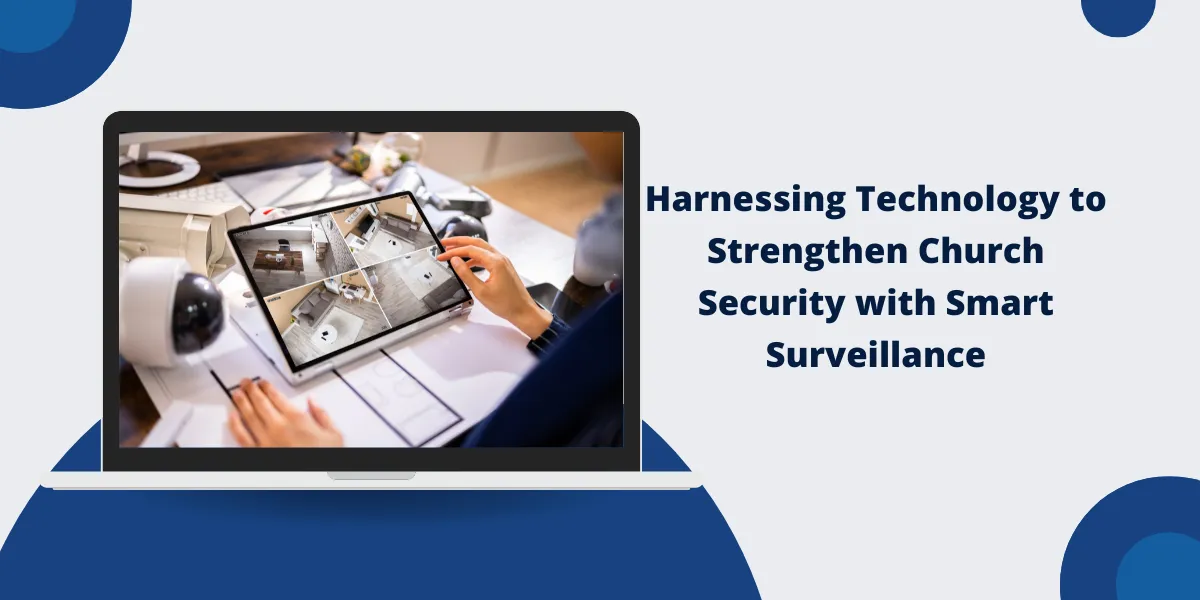Churches have long served as sacred spaces for worship, reflection, and community bonding. But in recent years, rising incidents of vandalism, theft, and other security breaches have made safety a pressing concern for religious institutions. No longer immune to modern threats, churches must adapt to ensure they remain havens for spiritual and communal life.
For instance, in 2023 alone, multiple churches across North America reported break-ins and property damage, often occurring during off-hours when no one was present to intervene. In some cases, the lack of surveillance made investigations nearly impossible, delaying justice and costing churches thousands in repairs and security upgrades.
This growing reality highlights a pressing need: churches must embrace proactive, technology-driven approaches to protect both people and property.
Why a Camera System Is Essential for Church Safety
Modern security demands more than locked doors and volunteer patrols. A professionally implemented camera system for churches plays a pivotal role in safeguarding church property and personnel. Here’s how it empowers churches:
1. Prevention Through Deterrence
The mere presence of visible surveillance cameras can dissuade potential wrongdoers from attempting illegal or disruptive activities. It’s a cost-effective psychological barrier that lowers the risk of security incidents.
In one widely reported incident, a local congregation installed visible cameras at every entrance. As a result, incidents of loitering and vandalism dropped by 75% within six months. Clearly marked signage also helped communicate that the church had moved to a “secure campus” model, which in itself discouraged inappropriate activity.
2. Real-Time Visibility
Advanced security systems offer live video monitoring, giving church staff or hired security professionals instant access to what’s happening on-site. This allows for quick response in emergencies, from medical incidents to suspicious behavior.
During high-attendance events like Sunday services, weddings, and holiday programs, real-time surveillance becomes a force multiplier. Churches can assign volunteers to monitor different zones via live feeds, making sure everything runs smoothly across large campuses.
3. Post-Incident Evidence Gathering
Should a security event occur, recorded footage becomes invaluable. It aids law enforcement investigations, clarifies misunderstandings, and strengthens insurance claims with concrete visual proof.
For example, a church in Georgia used security footage to successfully identify and prosecute a serial thief targeting religious institutions. The high-definition video provided timestamps and facial recognition data that matched police databases, leading to a swift arrest.
4. Remote and Mobile Access
Many modern systems support remote viewing through secure cloud platforms. This means designated individuals can monitor church grounds anytime, from anywhere—ensuring oversight even after hours or during special events.
This feature is especially beneficial for smaller congregations that don’t have the budget for full-time security personnel. Remote access enables trusted board members, volunteers, or IT administrators to respond quickly in case of an alert or emergency notification.
5. Integration with Broader Security Infrastructure
A modern camera system can integrate with other technologies such as smart locks, alarm systems, and visitor management platforms. This provides a cohesive and responsive security framework.
For example, if a door sensor detects forced entry, the camera system can automatically begin recording in that area and send real-time alerts to designated staff members’ mobile devices.
Steps to Implementing a Smart Security Camera System
Building a reliable camera system involves more than simply installing hardware. Here’s how churches can go about it strategically:
Conduct a Security Audit
Identify all vulnerable access points and congregation areas that require surveillance. This includes main entrances, side doors, parking lots, nursery areas, administrative offices, and high-value equipment rooms.
Choose the Right Equipment
Consider cameras with high-definition resolution, night vision, motion detection, wide-angle lenses, and weatherproof housing for outdoor placement. Dome and bullet-style cameras are popular choices depending on the area being monitored.
Churches should also assess storage requirements—whether on-site digital video recorders (DVR) or cloud storage—based on their budget and need for historical footage.
Hire a Professional Installer
A certified installer ensures optimal placement, secure connections, and minimal blind spots. Professional installation also guarantees that the system complies with privacy regulations and electrical safety codes.
Train Staff and Volunteers
Education is essential. Provide training on how to access live feeds, review recordings, and handle emergency alerts. Roles and responsibilities should be clearly defined to avoid confusion during high-stress situations.
Maintain Regularly
Schedule maintenance checks and software updates. Dust, wiring issues, or outdated firmware can render even the best equipment ineffective. Regular audits ensure system longevity and reliability.
Addressing Privacy and Ethical Concerns
It’s crucial to strike a balance between safety and privacy. Churches must communicate openly with their congregations about the presence and purpose of surveillance systems. Use clear signage and obtain legal advice to ensure compliance with local privacy laws.
Involving the community through informational sessions or Q&A forums can help build trust and transparency, especially when installing cameras in sensitive areas like children’s rooms or counseling offices.
The Financial Case: Investing in Peace of Mind
While some may view security upgrades as an added expense, they are, in reality, an investment. Most churches can find affordable packages that scale based on their facility size and needs.
Grants are also available through local safety initiatives and nonprofit support organizations. Partnering with local law enforcement or municipal safety programs can open doors to funding opportunities and professional guidance.
Moreover, many insurance providers offer premium reductions for institutions that implement certified security systems. This creates long-term savings and risk mitigation.
Community Engagement and Volunteer Involvement
Security doesn’t have to be a burden—it can be a community effort. Tech-savvy volunteers can assist with monitoring, maintenance, and software updates. Church members with law enforcement or military backgrounds can advise on threat scenarios and best practices.
Hosting safety workshops, fire drills, and emergency response training creates a culture of preparedness. Security becomes a ministry in itself—one that protects the physical and emotional well-being of every worshipper.
Building a Safer Space with Technology
Places of worship should remain peaceful and secure, not only for spiritual gatherings but for all the community services they provide. Embracing tools like a camera system for churches is not just a technological upgrade—it’s a necessary step toward ensuring long-term safety and confidence for congregants, clergy, and volunteers alike.
In today’s uncertain world, the presence of robust security systems reaffirms that churches take the safety of their communities seriously.
Case Study: A Real-World Transformation
To better illustrate the impact of smart surveillance, consider the case of Grace Haven Church, a mid-sized congregation located in a suburban area of Texas. Prior to implementing a comprehensive security camera system, the church faced repeated incidents of trespassing and minor vandalism. These events not only strained resources but also created anxiety among the staff and congregation.
With guidance from a local security consultant, Grace Haven invested in an integrated camera solution with cloud-based access, motion sensors, and mobile alerts. Within weeks of installation, suspicious activity around the premises declined significantly. The church also established a volunteer-run security committee that oversees the system and coordinates emergency responses.
Six months after implementation, not only had crime rates dropped to zero, but community confidence in the church’s safety surged. Parents felt safer dropping off their children for youth programs, and elderly members expressed appreciation for the increased attention to security. This transformation showcases the tangible benefits of proactive investment in surveillance technology.
Final Thoughts
Churches must evolve with the times, and security is a crucial area where technology can have a transformative impact. By investing in comprehensive surveillance solutions, religious institutions can confidently fulfill their mission of serving the community in a secure, protected environment.
Embracing modern security not only prevents harm but sends a powerful message: that a house of worship is also a house of safety, prepared for the challenges of the modern world.
Frequently Asked Questions (FAQs)
Are camera systems too expensive for small churches?
Not necessarily. There are scalable options available to fit nearly any budget. Many vendors offer basic packages that can be upgraded over time, and grants or insurance discounts may offset initial costs.
Will installing cameras make congregants feel uncomfortable?
Transparency and clear communication are key. Inform your congregation about the purpose of surveillance and where cameras are located. In most cases, members appreciate the enhanced safety.
Can we install and manage the system ourselves?
DIY installations are possible, but professional installation is recommended for proper configuration, optimal coverage, and legal compliance—especially in sensitive areas.
What happens if there’s a power outage or internet failure?
Most systems have backup battery support and local storage, allowing continued operation during short-term outages. Some advanced systems can also alert you to technical interruptions.
How often should the security system be reviewed or upgraded?
A review every 6–12 months is advisable. This includes checking camera angles, software updates, storage capacity, and changing needs based on new programs or facility expansions.
Churches must evolve with the times, and security is a crucial area where technology can have a transformative impact. By investing in comprehensive surveillance solutions, religious institutions can confidently fulfill their mission of serving the community in a secure, protected environment.
Embracing modern security not only prevents harm but sends a powerful message: that a house of worship is also a house of safety, prepared for the challenges of the modern world.

Priya Mervana
 Verified Web Security Experts
Verified Web Security Experts
Priya Mervana is working at SSLInsights.com as a web security expert with over 10 years of experience writing about encryption, SSL certificates, and online privacy. She aims to make complex security topics easily understandable for everyday internet users.



